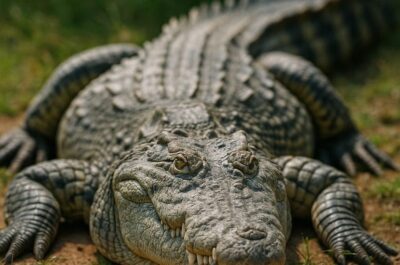 Crocodiles have ruled waterways for millions of years, almost unchanged since the days of dinosaurs. They are powerful, ancient, and terrifyingly efficient hunters. At Vero Q&A, we explore why crocodiles are often called “living dinosaurs” and what makes them such dominant predators even today.
Crocodiles have ruled waterways for millions of years, almost unchanged since the days of dinosaurs. They are powerful, ancient, and terrifyingly efficient hunters. At Vero Q&A, we explore why crocodiles are often called “living dinosaurs” and what makes them such dominant predators even today.
An Ancient Lineage
Crocodiles belong to a group of reptiles called archosaurs, which also includes dinosaurs and birds. They first appeared more than 200 million years ago, surviving mass extinctions and major planetary changes. Unlike most prehistoric creatures, crocodiles maintained their basic body structure, proving how well-adapted they are.
Built for Survival
Their bodies are armored with thick, scaly skin made of keratin and bony plates called osteoderms. This natural armor helps protect them from threats and aids in camouflage. Their long, powerful tails and webbed feet make them excellent swimmers, allowing them to glide silently through the water.
The Ultimate Ambush Predator
Crocodiles are patient hunters. They lie in wait near riverbanks, nearly invisible, until prey comes close. Then, in a flash, they strike with a jaw-snapping bite — one of the strongest in the animal kingdom, reaching 3,700 PSI (pound-force per square inch).
Once they grab their victim, they perform a “death roll,” spinning rapidly to subdue and dismember prey.
Cold-Blooded Advantage
As ectothermic animals (cold-blooded), crocodiles require far less food than warm-blooded animals of the same size. They can survive for months without eating and are known to store meat underwater, allowing them to wait for the perfect opportunity to feed again.
Incredible Senses
- Eyes: Positioned on top of their heads for stealthy stalking.
- Ears and Nostrils: Close during dives to remain submerged for long periods.
- Pressure Sensors: Located in the skin to detect water vibrations and movement.
All these features make them supreme predators in their habitats.
Global Distribution
Crocodiles are found on every continent except Europe and Antarctica. Species like the Nile crocodile, saltwater crocodile, and American crocodile dominate freshwater rivers, coastal areas, and even open seas.
Misunderstood Intelligence
Recent studies show crocodiles exhibit complex social behavior they cooperate during feeding, communicate through vocalizations, and even care for their young. This intelligence is often underestimated, but it contributes greatly to their success.
Human-Crocodile Conflict
As human settlements expand near water bodies, conflicts increase. Crocodile attacks on humans, though rare, are often fatal. Conservationists work to educate communities and create barriers to reduce these deadly encounters.
Crocodiles are more than just dangerous reptiles, they are living relics of Earth’s deep past. At Vero Q&A, we honor their place in natural history as survivors, hunters, and guardians of the waterways. Respect for these ancient predators is key to coexisting with them.
Why Are Crocodiles Considered Living Dinosaurs?
1. Are crocodiles actually dinosaurs?
No, but they are closely related and share a common ancestor with dinosaurs.
2. How long have crocodiles existed?
Over 200 million years long before the rise of mammals.
3. Can crocodiles swim in the ocean?
Yes, especially saltwater crocodiles, which can travel across seas.
4. Do crocodiles care for their young?
Yes, mothers guard nests and help hatchlings reach the water.
5. Why don’t crocodiles change much over time?
Their body design is nearly perfect for survival, so there’s been little need for evolutionary change.
6. Are crocodiles endangered?
Some species are, due to habitat loss and hunting, though others are stable or even increasing.